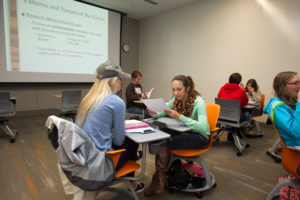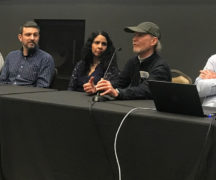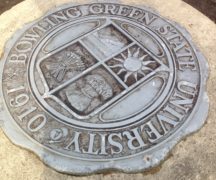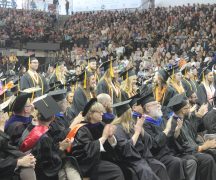By DAVID DUPONT
BG Independent News
It’s not even 8 o’clock yet and Susan Kleine’s morning Business 1100 class is already on a roll.
As students come in, they gather Sharpie markers, Post-It Notes, tape and colored pipe cleaners from a table at the front.
Then Kleine directs them to get into groups of four. The students roll their chairs, some without even getting up, around small tables, also on wheels.
The assignment is to design the ideal wallet. Now students face off to question each other about their wallets, or the equivalent, how they use them and what their drawbacks and advantages are.
The students, meeting on the second floor of the Education Building, are involved, though they may not be aware of it, in a movement to redesign the university classroom.
Bowling Green State University is engaged in an ongoing effort to improve its classrooms. The project is part capital renovation, and part ongoing experiment. These new active learning classrooms have their share of technology, yet the emphasis is on the human touch.
They are reshaping teaching on campus.
“In traditonal sense, we think of the classrooms as being neat rows of students and the teacher in front of those rows spouting out information,” said Mary-Jon Ludy, who teaches nutrition classes. “If I think about that happening in classrooms today, if they’re not engaged, they either fall asleep or they do something else.”
Instead of fighting those tendencies, the new active learning classrooms put them to use.
Many of the classrooms have whiteboards on all walls, so students can get up work out problems and brainstorm ideas. Then they take out their own personal technology and take photos for later use and sharing.
 John Fisher, vice provost for academic affairs, said the process of upgrading the classrooms began about three years ago with an inventory of learning spaces on campus, and a calculation of how many would be needed. This comes as the university is in the midst of a renovation boom, retrofitting classic buildings for the demands of contemporary education.
John Fisher, vice provost for academic affairs, said the process of upgrading the classrooms began about three years ago with an inventory of learning spaces on campus, and a calculation of how many would be needed. This comes as the university is in the midst of a renovation boom, retrofitting classic buildings for the demands of contemporary education.
Two years ago, work started on the west side of Olscamp Hall. This was the beginning of an “ongoing research” project to find what works best, he said. The classrooms in Olscamp were used as prototypes for the way learning spaces were then developed on the second floor of the Education Building, in Math and Science, in Eppler and in Business Administration as well as the new home for architecture. Some are fully tricked out with all manner of technology like document cameras and full video capability, not to mention white board tables and walls. Others, including most in Business Administration, received more modest make overs, but still reflect the new approach.
At this point about half the university’s approximately 160 classrooms have been completed. That number will increase next fall when the new School of Media and Communications building opens and the renovations of Mosely and University halls are completed.
In Mosley, which will be used for lower level science courses, the lab spaces will be built right into the classrooms, Fisher said.
Mary-Jon Ludy said: “I always think about teaching as a grand experiment. You have to be willing to experiment and willing to fail. If your students know that and have that expectation they’re fine with it.”
Amanda Muhammed, who teaches fashion merchandising, said teaching in these rooms “makes it more interesting for me.”
Lectures like those she had as a student, what she terms “the sage on a stage,” are “too dry.”
“I can see the students tuning out.”
So Muhammed and other professors flip the instruction. Instead of the class time being used to impart the essential information with the elaboration then happening out of the classroom, students are assigned to read material, or watch a video of a lecture, or a documentary.
Then in class they put what they learned to use. For Muhammed that students can get full use of their laptops in these spaces is important.
Given the ever changing nature of the fashion business, they access blogs and social media to do case studies on products just coming on the market.
“I find students can make stronger connections when they see it being used in a real world context,” she said.
More often than not that work is done in groups. As in Kleine’s class, students work together to explore a topic.
Ludy said the advantage is: “They get to know each other and care about each other. It leads to a classroom environment where there’s more discussion.”
That’s useful for her because her nutrition classes bring together students from several programs.
And for the students in Kleine’s class this is a big part of the appeal.
Jacob Houtz likes the fact that the seating is constantly changing. “This gives you a chance to move around.”
Melvin Jackson enjoys the face-to-face encounters with his classmates. So often in high school, the higher achieving students seemed not to be able to communicate with others. “When you interact, you have to explain your work.” And for a more verbal student like him “that gives you an edge.”
“It’s all about exchanging ideas,” said Cory Garbe. The mix of activities helps him learn. If he has to just sit and listen, he said, “I don’t feel I can retain the material.”
“It forces the students to talk to each other and collaborate,” said Amy Morgan, of the College of Education & Human Development. Now an associate dean she has experience both teaching in the spaces and as a mentor and administrator. “Students don’t all learn the same way. It opens up the possibility to reach more learning styles. It’s not passive learning. It’s thinking about it and figuring it out.”
Those teaching in the spaces have to adjust as well. “It forces people to do things in a different way. We all get comfortable teaching in a certain way. If asked to teach in another way it takes us out of our comfort zone,” Morgan said.
The Center for Faculty Excellence on campus has been central to providing training and mentoring in the use of the new spaces.
Even someone as experienced in their use as Morgan admits there are some technologies she’s still learning about.
Ludy said some are concerned these more fluid spaces make cheating more likely. There are ways to structure testing to get around this, she said. But she’s not concerned for another reason. “When you’re in an active learning environment you get to know your students better and there’s a little more respect.” That makes cheating less likely than in an environment where a student is “just a number.”
After these open, Fisher said, there will be a pause to reassess what is needed for the remaining spaces.
The performing arts buildings Moore Musical Arts and the Wolfe Center pose particular challenges since spaces serve multiple and conflicting uses, from individual practice to group rehearsals and classrooms.
Administrators are still pondering how to handle the largest classrooms, which by some standards are small. BGSU doesn’t have 500-seat lecture halls, the largest is about 200 seats, and it is one of the least used rooms, Fisher said. University Hall will have a a 100-seat active learning room on the third floor in the space left after the demolition of the two theaters. With “glorious views,” Fisher noted.
The most in-demand classrooms seat 50 to 60 students.
Morgan said: “The caution from the administration standpoint is we have to be sure that we have rooms for those people who don’t want to make the switch.”
Ludy is on the other extreme. “Most of the time I’m able to use those classrooms. I’m fortunate in that regard. I don’t have to worry about going back to some archaic format.”





